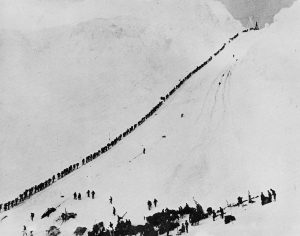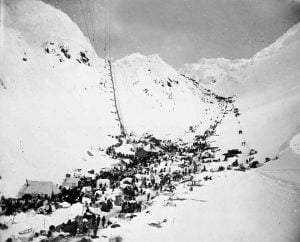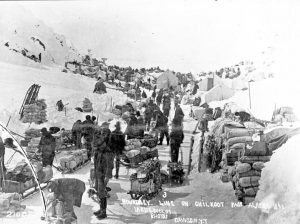The Seventh Season of Gold Rush has wrapped up. While Hoffman is redirecting his media celebrity onto preppers, the young Parker Schnabel is doubling down with a special Gold Rush series of his own. In Gold Rush: Parker’s Trail. Parker and friends will travel the route of early miners during the Alaska Gold Rush.
If the Discovery Channel previews are anything to go on, there will be hiking, rafting, and no shortage of drama. They will follow in the footsteps of the 100,000 miners who traveled the Klondike Gold Rush trail. At that time, only one in three miners ever made it to the end of the trail.
In this 3-part docu-series, Parker is joined by three close friends. Gold Rush fans will be familiar with Parker’s foreman Rick Ness. Fans may also have some memory of a truck driver, Karla Ann, who will also be joining in. Though, it is her experience as a wilderness guide that makes her particularly qualified for this journey. Less recognizable will be the third member: cameramen James Levelle,
The series premiers Friday, March 31 at 9 PM, Eastern Standard Time.
Klondike Gold Rush
The Klondike Gold Rush began August 16, 1896 on Bonanza Creek, 50 miles east of the Alaskan border. The eager gold hunters were called “stampeders.” Overeager and underprepared miners rushing to the undeveloped wilderness of the Klondike. Concerned Canadian officials began to require “stampeders” to bring one ton of goods per person—considered to be one years worth of provisions. That requirement might not have been that bad, had they not had to face the Chilkoot Trail.
Klondike Gold Rush trail: Chilkoot Trail
Presumably, Gold Rush: Parker’s Trail refers to Chilkoot Trail. In the promotional video, we see the well known image of miners scaling Chilkoot Pass. The Chilkoot Trail travels 33 miles from Dyea, Alaska to Lake Bennett, British Columbia. The route was so rugged that wagons and animals could not travel it. Everything had to be carried by people. Only the wealthiest miners could afford to hire others to carry their equipment. It is estimated that, for every mile that the miner’s provisions traveled, the miner had to walk 80 miles.
Chilkoot Pass
Chilkoot Pass is the highest point along the Chilkoot Trail, where miners transition from Alaska into Canada. Miners trudged single file, up 45° grades to scale the 3057 ft. elevation pass. But they didn’t do this once. It would take multiple rounds traveling up and down the pass for miners to transport all the supplies they would need to mine the Klondike. We are curious to see how historically accurate Parker and his crew will be when they scale the Chilkoot Pass.



